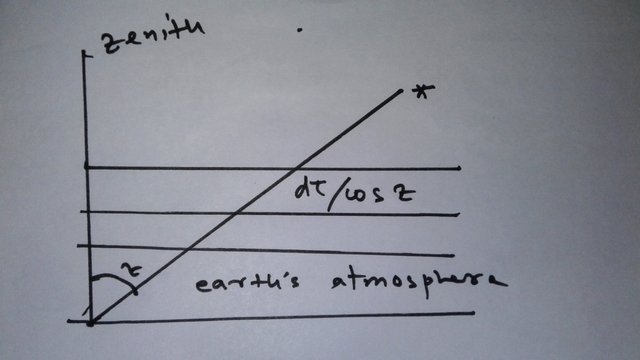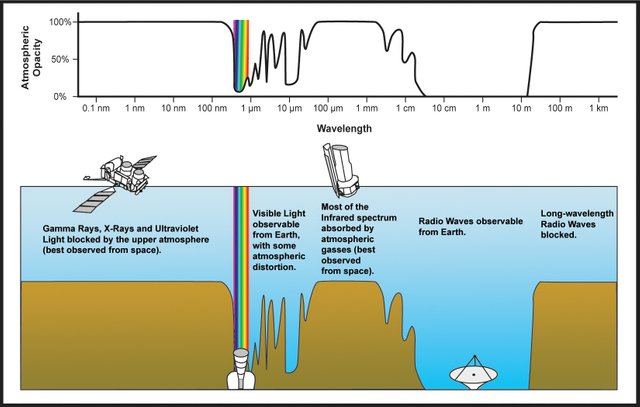A: How does the earth atmosphere effect the astronomical observations ?
For us, as astronomers, it is really important to understand the phenomenon in the earth's atmosphere for which the radiation of stellar objects can change. Down below, I am going to talk about the basic reasons for which we get a changed view of stellar radiation. Those causes are refraction, scintillation, and extinction. For example, because of the refraction of light, the real position of the stellar object and the measured position of the stellar object is not in the same place. Nonhomogeneity and turbulence in the earth's atmosphere distort the image of the stellar object and at the same time absorption and scattering of light can make the stellar objects look less brightness than its normal brightness.
Refraction
Eartth's atmosphere is nonhomogenous where density decreases with the height and it decreases exponentially. It can be described by the formula-

here  is the density at height h and
is the density at height h and  is when h=0. H is the scale of height, it is the height when the density decreased e times.
is when h=0. H is the scale of height, it is the height when the density decreased e times.

If we look at the picture up we can see that stars original position is at P but we see it in the position P'. This happens because of the effect of refraction. The more nearby the star towards the horizon, the more radiation is refracted. Because as we know when light fall in the boundary of two layers with different density will refract. So, when these rays go through a series of refraction in the layers with different density, due to refraction we will observe the stellar object upper than it usually is. But a star in the zenith is not affected by this effect as it falls with a right angle on the layers.
Here is the formula which describes refraction, universally known as Snell's law.
 and
and  are index of refraction and
are index of refraction and  is the incident angle and
is the incident angle and
 angle of refraction.
angle of refraction.
Because of atmospheric refraction some every day's phenomenon happens. For example, dawn and dusk-length of the day are longer although the sun is below the horizon.
Transportation of radiation through a medium doesn't depend only on the properties of that medium as well as on the wavelength of the radiation. We know that the velocity of propagation depends on various parameters. For example, time and wavelength. So, the index of refraction should as well as they are closely related.
 )
)Scintillation
The scintillation of stars is a rapid change in its brightness. It happens because of the chaotic nature of our atmosphere, as it is nonhomogenous and nonstatic. As the light wave passes through these layers of the atmosphere, scintillation happens. For every nonhomogeneity acts like an optical lens. Plane wavefront deforms because of continuous change of index of refraction which can cause fluctuation in temperature and density. For all these reasons, fluctuation in the amplitude can happen which can cause a rapid change in the brightness. For a point source it creates a flashing effect but for the source like planets, this effect doesn't happen.Extinction
We know that as the electromagnetic wave passes through any medium it can be absorbed or scattered. This effect can bring about weakening or the extinction of the electromagnetic radiation. In the case of absorption, it is interesting as the absorbed EM waves can increase the temperature of the gas molecule of the atmosphere. Atoms can absorb a photon if the energy of the photon is same as the energy in between two discrete energy level of the atom.

Scattering happens when EM waves interact with the particles of the atmosphere and change its direction of propagation and change its wavelength as well. The difference between absorption and scattering is that for scattering the amount of EM radiation is not decreased only decreased in a particular direction. Scattering in molecules and atoms are known as Rayleigh scattering. The intensity of the scattered radiation is inversely proportional to the fourth power of wavelength.



 is the intensity in the earth's surface,
is the intensity in the earth's surface,  is opacity and
is opacity and  is the intensity in the upper boundary of earth's atmosphere.
is the intensity in the upper boundary of earth's atmosphere.

Reference
1. Carroll and Ostlie, An Introduction to Modern Astrophysics
2. Olga Atanackovic, General Atrophysics
3. Mirjana Vukicevic, Theoretical Astrophysics
4. Erika Bohm Vitense, Introduction to stellar astrophysics
**StemQ Notice:** *This post was originally submitted on [StemQ.io](http://www.stemq.io), a Q&A application for STEM subjects powered by the Steem blockchain.*
This post has been voted on by the SteemSTEM curation team and voting trail in collaboration with @utopian-io and @curie.
If you appreciate the work we are doing then consider voting all three projects for witness by selecting stem.witness, utopian-io and curie!
For additional information please join us on the SteemSTEM discord and to get to know the rest of the community!
Hi @rifkan!
Your post was upvoted by Utopian.io in cooperation with @steemstem - supporting knowledge, innovation and technological advancement on the Steem Blockchain.
Contribute to Open Source with utopian.io
Learn how to contribute on our website and join the new open source economy.
Want to chat? Join the Utopian Community on Discord https://discord.gg/h52nFrV
Congratulations @rifkan! You have completed the following achievement on the Steem blockchain and have been rewarded with new badge(s) :
Click here to view your Board of Honor
If you no longer want to receive notifications, reply to this comment with the word
STOPCongratulations @rifkan! You have completed the following achievement on the Steem blockchain and have been rewarded with new badge(s) :
Click here to view your Board of Honor
If you no longer want to receive notifications, reply to this comment with the word
STOPDo not miss the last post from @steemitboard:
Congratulations @rifkan! You have completed the following achievement on the Steem blockchain and have been rewarded with new badge(s) :
Click here to view your Board of Honor
If you no longer want to receive notifications, reply to this comment with the word
STOPDo not miss the last post from @steemitboard: